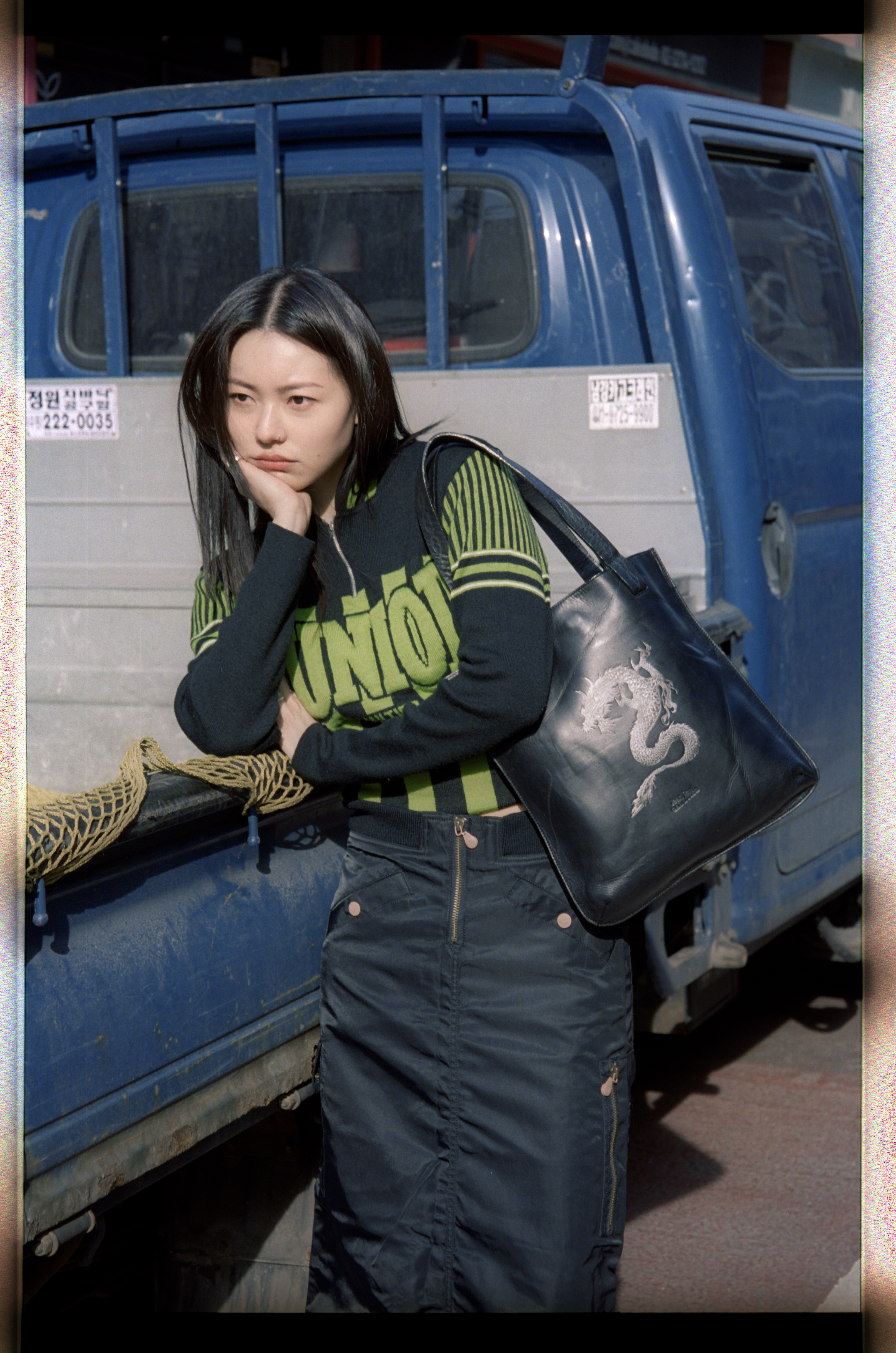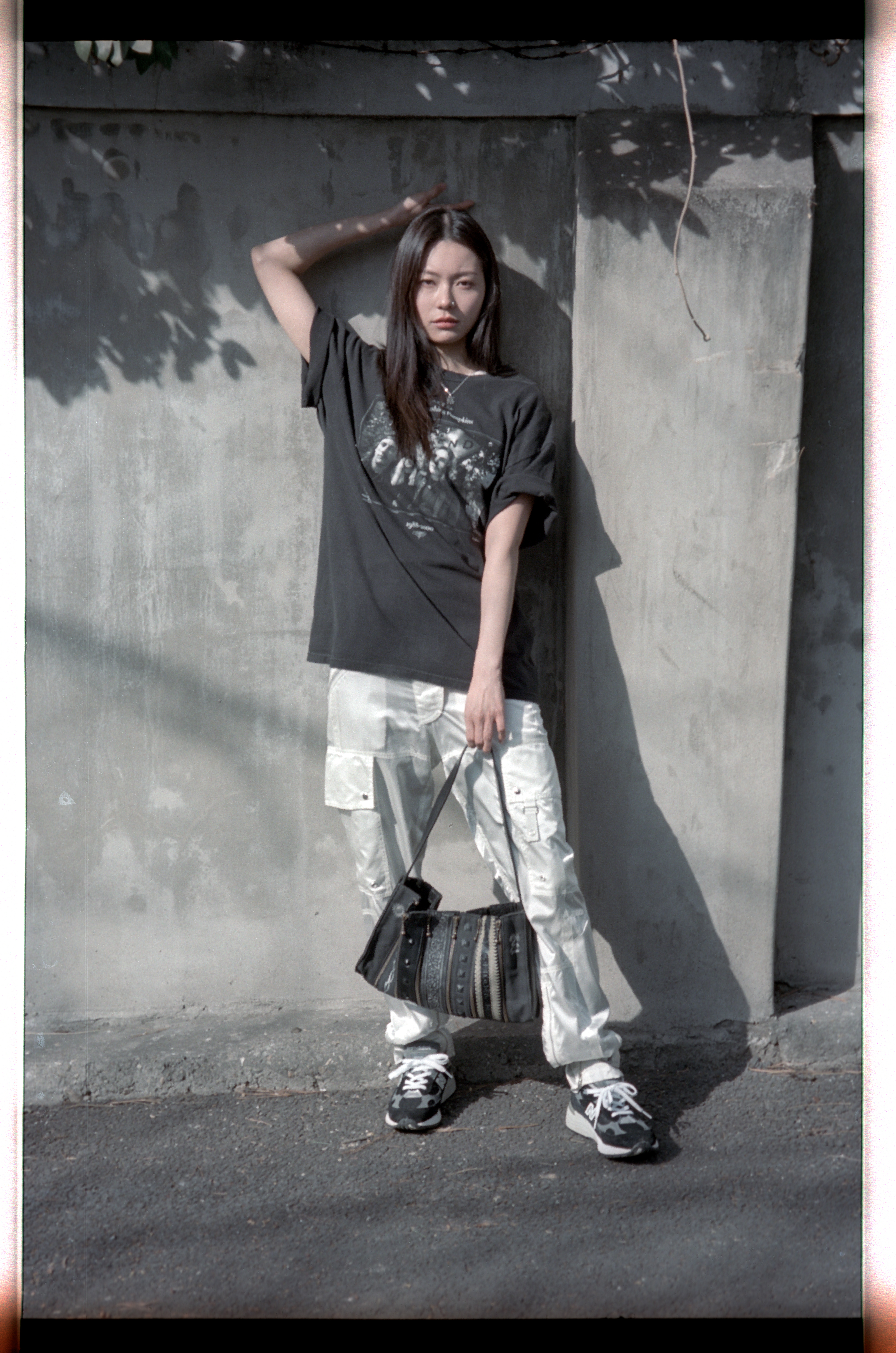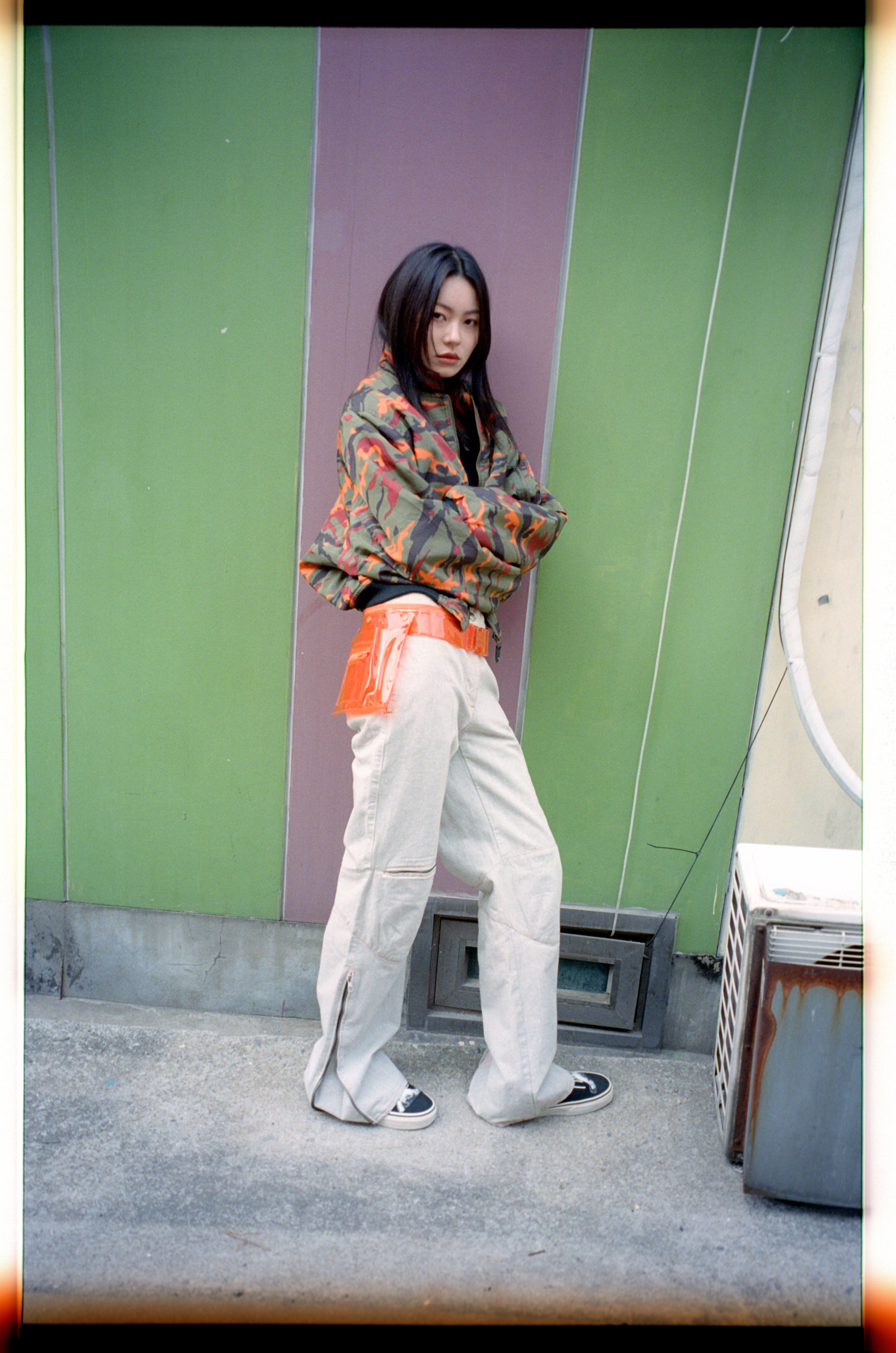INTERVIEW WITH DUMDUM SHOWROOM
The vintage fashion scene is still young in Seoul, where shoppers are known for their devotion to new clothes over old ones. Yet the city happens to be home to one of the most exciting little spots to pop up in the last decade: Dumdum Showroom, an exclusive hole-in-the-wall shop with a cult following and a meticulous curation of exquisite pieces.
To enter Dumdum, one must make an appointment with Won and Darum, the amiable couple who keep the showroom stocked with an eclectic mix of garments, accessories, and tchotchkes. A Miu Miu SS99 harness bag hangs on a rack next to a Jean Paul Gaultier bodycon dress and a David Lynch Twin Peaks tee; two Björk Space Age snapbacks sit on the neighboring shelf. No wonder international fashion favorites flock to Dumdum whenever they swing through town, Naomi Campbell and repeat visitor ASAP Rocky among them.
Here, Won and Darum talk through the origins of Dumdum, the state of vintage in South Korea, and the curatorial philosophy that sets their showroom apart.

Tell us about the beginning of Dumdum. How did you get started?
Won: Six years ago, I started Dumdum by myself. Then two years later, I met my girlfriend and business partner Darum.
Darum: And from then we started running the shop together.
Won: For three years we had a shop in Hongdae, and then we moved to our showroom further east.

How did you fall in love with vintage?
Won: I always liked vintage clothes as a consumer. I actually moved to Canada during my second year of middle school and grew up there. From when I was young, I would go to vintage shops with my friends and, finding cheap and good-looking clothes, I just bought them without any particular thought. After I turned 32, I returned to Korea. I had been working at a company overseas, but I didn’t want to work at a company in Korea. I wanted to do something fun, something interesting. Giving it some thought, what came to my mind was vintage. After coming to Korea, I went on a trip to Thailand for fun. The vintage market there is really big, and seeing it in motion, I thought oh, if I did something like that in Korea, it could be nice, it could do well. So that’s how I came into the business.
Darum: I studied fashion design, actually. I graduated then worked in America for one year before coming back to Korea. For me, it was on a trip to Japan that I became interested in vintage and kept searching for it. I really liked designer vintage, like Gaultier, Prada. Then after meeting Won, from there I think I fell even more into it.
How did you two meet?
Won: We met at the store in Hongdae. We had mutual friends, and they came together to the store one day. Back then, I used to put clothes on friends, take photos, and put them up on Instagram. But I only had male friends, so after meeting Darum, I asked her to model a few times and then... [laughs]. At that time, I didn’t sell designer vintage. I did a lot of true vintage, a lot more old clothes. Old Levi’s, vintage t-shirts. The chance came after I met Darum. There was the collection that I already had and her collection.
Darum: I added to it a bit, you know? It grew from there.
Won: Our sensibilities mixed. So we did designer and true vintage from then on.

Tell us about your sourcing process.
Darum: We don’t source from any one place, but little by little, every day, we search and bring pieces together. So we found over time the amount had increased by this much.
Won: In the case of band tees, for example, it happens organically. I listen to the music that I like, and then I can go out and buy t-shirts and other merch from those artists. We do a lot of sourcing that way.
Darum: When we first started together, we took a research trip to Japan. Brands tend to sell a lot more there, so there was a lot of vintage to see. Later, when we started sourcing, we looked overseas, in Japan, also in Korea whenever possible. Everywhere we could possibly find anything, we looked.
Won: And then there’s the vintage community on Instagram and other social media platforms. It’s a real community, although we only know each other online. We send each other messages and exchange items. We source there too. There are so many ways, we look for every single place we can possibly source from.

Do you find much vintage in Korea, or do you find more overseas?
Won: Right now there’s a lot more, but when we started...
Darum: There really wasn’t any at all.
Won: There weren’t people selling it, and there also wasn’t any real interest in it in Korea. There wasn’t as much overseas either. But there was one great thing about that. In Korea, people didn’t place any value on old or worn items, preferring to buy new things instead. A lot of Koreans love to buy a lot of designer clothes. After a time, they don’t want to wear those old designs anymore, so they sell them cheaply. So at that time we sourced in Korea so easily. In those early days, there were actually a lot of good pieces for re-sale, and we really were able to gather a lot. Compared to before, there’s a lot more interest in vintage here and overseas too. In Korea, bit by bit, people are coming around.
What sets Dumdum apart from other vintage shops in Korea?
Darum: The people who come to our shop are a little different taste-wise.
Won: But we sell a lot of t-shirts. People come here a lot to look for t-shirts. Compared to other vintage shops, we definitely have the widest variety of tees. I would say we are more based in culture. That is what we look for. At Dumdum, we want to show pieces that are grounded in culture. That’s where we put our biggest effort. Even though we stock designers, we still look for designers whose work is shaped by a form of culture. It could be as simple as a designer who received inspiration from a specific culture or piece of pop culture then made a collection around that. Those are the designers we pay more attention to. Japanese designers tend to do that a lot—work around a band they love, a cultural figure who inspired them. Before we purchase anything, we always look first at the design and then look a second time, considering the cultural aspect. We want fashion that has a story. We are always looking for the story.
Darum: We want to have those brands that are more layered and have more depth.
Won: If the clothes are pretty too, that’s even better. But we are shaping and showing our own point of view, and that is what’s most important.

Tell us a bit about the showroom itself.
Won: We try to keep it looking as clean as possible. It’s not a shop we open every day, but more a showroom. We only do Instagram.
Darum: People can really only find us through Instagram then make an appointment through direct message.
Won: We only do the showroom through appointment. In Hongdae, I opened every day. The first two years, I opened the store every day. But people would wander into the shop a little too randomly, and there was something that didn't feel right about that.
Darum: It’s difficult when there’s a lack of understanding with vintage. Why is it this kind of shop? If they don’t understand what we’re trying to do, it's challenging. And we felt those differences kept arising.
Won: So we started filtering bit by bit. And then when we moved to this location and decided to do it as a showroom and only receive appointments. We liked it more that way. The sales gets better.
Darum: For the people who came too, we were able to match their tastes and prepare a selection in advance. So the customer liked that a lot, and we were able to show pieces in a more personalized way.
Won: We take commissions to search for clients, too. If they are searching for something in particular, we will track it down and contact them to come pick it up.
When did you start doing that?
Won: After clients like that appeared [laughs]. Every day is different, so it’s fun. Even just finding clothes is fun. Since we operate by appointment, we are at home a lot, looking for clothes and always researching.

In your experience, how are vintage shoppers in Korea different from those overseas?
Won: The thoughts on vintage are completely different in Korea and the U.S., for example. In Korea, the brand names are more important, and the condition is very important. Pretty things do well. But overseas, vintage people tend to be very certain in their personal tastes and their individual style. Collecting can be more focused. If they like Levi’s, only Levi’s. Nike, then only Nike. Sport, then only jerseys.
Darum: As far as Korean customers and sellers go, they look first at whether or not they will wear the piece. That’s how they decide what to buy and sell. But overseas customers that we’ve seen, even if they don’t want to wear it, they will buy it just because they like it. There’s been a lot of cases like that.
Won: The way of thinking is different.
Darum: Even if it doesn’t fit, just because they like it, they will buy it.
Won: The difference is big.
Do you have a favorite piece that you’ve found over the years?
Darum: We sold it, of course [laughs].
Won: Hers was an ’80s Issey Miyake Umbro promo jacket. When they did the show, they only gave them to the staff.
Darum: It was reversible, similar to a MA-1.
Won: We actually found it in Korea. We bought it 4 or 5 years ago for only 50,000 won [$40 USD]. The seller didn’t even know, they thought it was just a jacket. For the description, they wrote it just as “jacket.” That’s another fun point of vintage. That feeling of discovery.
Darum: Now there’s almost nothing to discover like that.
Won: It got so much harder in Korea even. There are a lot more friends looking for it, and overseas the competition became so extreme. Vintage Jordans, for example, people buy them and show them off, oh I found that. It’s so extreme. For me, I love t-shirts. What I love the most is movies, so more than band t-shirts, I like to search for movie t-shirts. Those are much harder to find, and they’re what I want to find most. I had an old Edward Scissorhands t-shirt, vintage David Lynch t-shirts. I loved those.
Darum: There really aren’t that many movie t-shirts.
Won: At concerts and tours they sell a lot of band tees, but movies...
Darum: There isn’t a big need to make them.
Won: People don’t really buy movie tees, you know. So there aren’t a lot of vintage ones remaining.

What are Koreans looking for most these days?
Won: Is it still Gaultier these days? These days Gaultier is still big, but this too shifts a lot with trends. When the monogram was really big, we sold so much Dior and Fendi.
Darum: It was so hot for a bit, but not anymore.
Won: It’s changed a lot. Gaultier mesh does well, and Prada. The trends are always changing. A lot of men tend to come for the t-shirts, a lot of women for the designer. But until now, Korean women didn't really love used items or the worn feeling of vintage clothes. They wanted cleaner stuff. The designer vintage feels a bit more clean.
Darum: More than clothes, I think women come a lot for purses and accessories.
Last, but not least, could you share the story behind the name, Dumdum?
Won: People ask us this a lot, but there’s not any great meaning behind it. I named it without any real thought. I like dumdum things. The Korean phrase dumdumhada, do you know what that means? It’s simple, but not trying too hard. Simple, easy, natural, dumdum. If you apply it to wearing clothes, dumdum is simple, not cheesy, not too much.

Dumdum Showroom
photography_ GUNO LEE
styling & interview text_ MONICA KIM
model_ SERIN JANG
